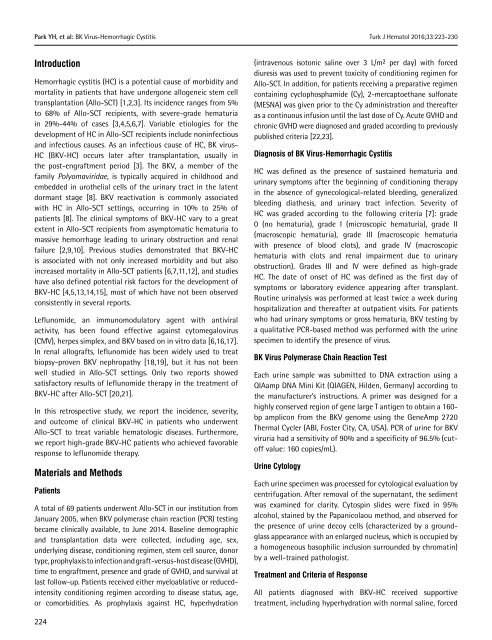Turkish Journal of Hematology Volume: 33 - Issue: 3
You also want an ePaper? Increase the reach of your titles
YUMPU automatically turns print PDFs into web optimized ePapers that Google loves.
Park YH, et al: BK Virus-Hemorrhagic Cystitis<br />
Turk J Hematol 2016;<strong>33</strong>:223-230<br />
Introduction<br />
Hemorrhagic cystitis (HC) is a potential cause <strong>of</strong> morbidity and<br />
mortality in patients that have undergone allogeneic stem cell<br />
transplantation (Allo-SCT) [1,2,3]. Its incidence ranges from 5%<br />
to 68% <strong>of</strong> Allo-SCT recipients, with severe-grade hematuria<br />
in 29%-44% <strong>of</strong> cases [3,4,5,6,7]. Variable etiologies for the<br />
development <strong>of</strong> HC in Allo-SCT recipients include noninfectious<br />
and infectious causes. As an infectious cause <strong>of</strong> HC, BK virus-<br />
HC (BKV-HC) occurs later after transplantation, usually in<br />
the post-engraftment period [3]. The BKV, a member <strong>of</strong> the<br />
family Polyomaviridae, is typically acquired in childhood and<br />
embedded in urothelial cells <strong>of</strong> the urinary tract in the latent<br />
dormant stage [8]. BKV reactivation is commonly associated<br />
with HC in Allo-SCT settings, occurring in 10% to 25% <strong>of</strong><br />
patients [8]. The clinical symptoms <strong>of</strong> BKV-HC vary to a great<br />
extent in Allo-SCT recipients from asymptomatic hematuria to<br />
massive hemorrhage leading to urinary obstruction and renal<br />
failure [2,9,10]. Previous studies demonstrated that BKV-HC<br />
is associated with not only increased morbidity and but also<br />
increased mortality in Allo-SCT patients [6,7,11,12], and studies<br />
have also defined potential risk factors for the development <strong>of</strong><br />
BKV-HC [4,5,13,14,15], most <strong>of</strong> which have not been observed<br />
consistently in several reports.<br />
Leflunomide, an immunomodulatory agent with antiviral<br />
activity, has been found effective against cytomegalovirus<br />
(CMV), herpes simplex, and BKV based on in vitro data [6,16,17].<br />
In renal allografts, leflunomide has been widely used to treat<br />
biopsy-proven BKV nephropathy [18,19], but it has not been<br />
well studied in Allo-SCT settings. Only two reports showed<br />
satisfactory results <strong>of</strong> leflunomide therapy in the treatment <strong>of</strong><br />
BKV-HC after Allo-SCT [20,21].<br />
In this retrospective study, we report the incidence, severity,<br />
and outcome <strong>of</strong> clinical BKV-HC in patients who underwent<br />
Allo-SCT to treat variable hematologic diseases. Furthermore,<br />
we report high-grade BKV-HC patients who achieved favorable<br />
response to leflunomide therapy.<br />
Materials and Methods<br />
Patients<br />
A total <strong>of</strong> 69 patients underwent Allo-SCT in our institution from<br />
January 2005, when BKV polymerase chain reaction (PCR) testing<br />
became clinically available, to June 2014. Baseline demographic<br />
and transplantation data were collected, including age, sex,<br />
underlying disease, conditioning regimen, stem cell source, donor<br />
type, prophylaxis to infection and graft-versus-host disease (GVHD),<br />
time to engraftment, presence and grade <strong>of</strong> GVHD, and survival at<br />
last follow-up. Patients received either myeloablative or reducedintensity<br />
conditioning regimen according to disease status, age,<br />
or comorbidities. As prophylaxis against HC, hyperhydration<br />
(intravenous isotonic saline over 3 L/m 2 per day) with forced<br />
diuresis was used to prevent toxicity <strong>of</strong> conditioning regimen for<br />
Allo-SCT. In addition, for patients receiving a preparative regimen<br />
containing cyclophosphamide (Cy), 2-mercaptoethane sulfonate<br />
(MESNA) was given prior to the Cy administration and thereafter<br />
as a continuous infusion until the last dose <strong>of</strong> Cy. Acute GVHD and<br />
chronic GVHD were diagnosed and graded according to previously<br />
published criteria [22,23].<br />
Diagnosis <strong>of</strong> BK Virus-Hemorrhagic Cystitis<br />
HC was defined as the presence <strong>of</strong> sustained hematuria and<br />
urinary symptoms after the beginning <strong>of</strong> conditioning therapy<br />
in the absence <strong>of</strong> gynecological-related bleeding, generalized<br />
bleeding diathesis, and urinary tract infection. Severity <strong>of</strong><br />
HC was graded according to the following criteria [7]: grade<br />
0 (no hematuria), grade I (microscopic hematuria), grade II<br />
(macroscopic hematuria), grade III (macroscopic hematuria<br />
with presence <strong>of</strong> blood clots), and grade IV (macroscopic<br />
hematuria with clots and renal impairment due to urinary<br />
obstruction). Grades III and IV were defined as high-grade<br />
HC. The date <strong>of</strong> onset <strong>of</strong> HC was defined as the first day <strong>of</strong><br />
symptoms or laboratory evidence appearing after transplant.<br />
Routine urinalysis was performed at least twice a week during<br />
hospitalization and thereafter at outpatient visits. For patients<br />
who had urinary symptoms or gross hematuria, BKV testing by<br />
a qualitative PCR-based method was performed with the urine<br />
specimen to identify the presence <strong>of</strong> virus.<br />
BK Virus Polymerase Chain Reaction Test<br />
Each urine sample was submitted to DNA extraction using a<br />
QIAamp DNA Mini Kit (QIAGEN, Hilden, Germany) according to<br />
the manufacturer’s instructions. A primer was designed for a<br />
highly conserved region <strong>of</strong> gene large T antigen to obtain a 160-<br />
bp amplicon from the BKV genome using the GeneAmp 2720<br />
Thermal Cycler (ABI, Foster City, CA, USA). PCR <strong>of</strong> urine for BKV<br />
viruria had a sensitivity <strong>of</strong> 90% and a specificity <strong>of</strong> 96.5% (cut<strong>of</strong>f<br />
value: 160 copies/mL).<br />
Urine Cytology<br />
Each urine specimen was processed for cytological evaluation by<br />
centrifugation. After removal <strong>of</strong> the supernatant, the sediment<br />
was examined for clarity. Cytospin slides were fixed in 95%<br />
alcohol, stained by the Papanicolaou method, and observed for<br />
the presence <strong>of</strong> urine decoy cells (characterized by a groundglass<br />
appearance with an enlarged nucleus, which is occupied by<br />
a homogeneous basophilic inclusion surrounded by chromatin)<br />
by a well-trained pathologist.<br />
Treatment and Criteria <strong>of</strong> Response<br />
All patients diagnosed with BKV-HC received supportive<br />
treatment, including hyperhydration with normal saline, forced<br />
224

















